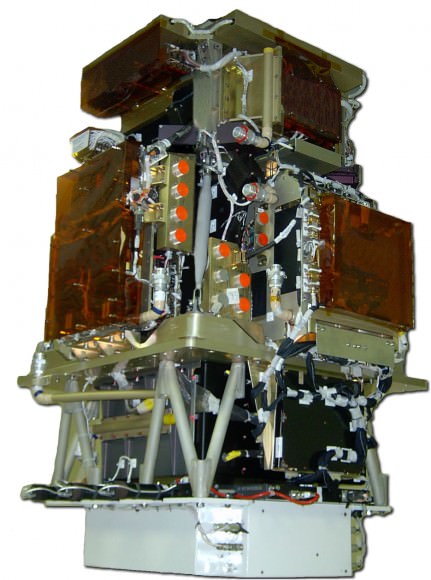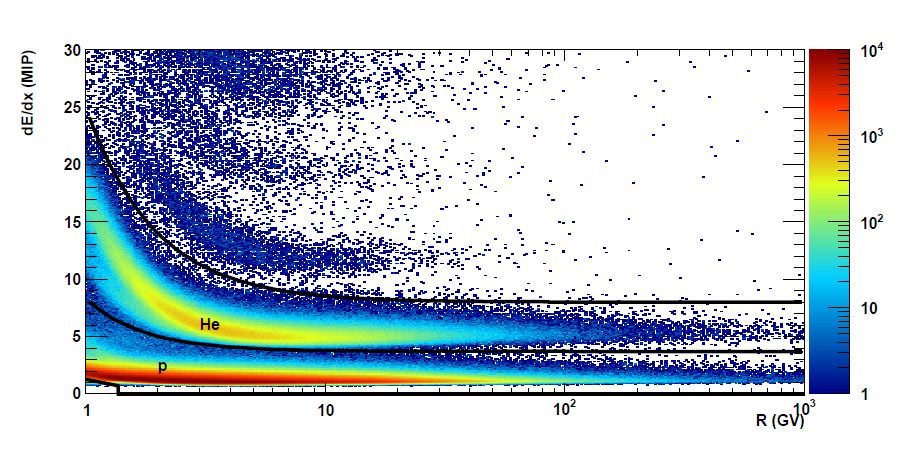[/caption]
High energy particles called cosmic rays are constantly bombarding Earth from all directions, and have been thought to come from the blast waves of supernova remnants. But new observations from the PAMELA cosmic ray detector show an unexpected difference in the speeds of protons and helium nuclei, the most abundant components of cosmic rays. The difference is extremely small, but if they were accelerated from the same event, the speeds should be the same.

PAMELA, the Payload for Anti-Matter Exploration and light-Nuclei Astrophysics, is on board the Earth-orbiting Russian Resurs-DK1 satellite. It uses a permanent magnet spectrometer along with a variety of specialized detectors to measure the abundance and energy spectra of cosmic rays electrons, positrons, antiprotons and light nuclei over a very large range of energy from 50 MeV to hundreds of GeV.
Just as astronomers use light to view the Universe, scientists use galactic cosmic rays to learn more about the composition and structure of our galaxy, as well as to find out how things like how nuclei can accelerate to nearly the speed of light.
Oscar Adriani and his colleagues using the PAMELA instrument say their new findings are a challenge to our current understanding of how cosmic rays are accelerated and propagated. “We find that the spectral shapes of these two species are different and cannot be well described by a single power law,” the team writes in their paper. “These data challenge the current paradigm of cosmic-ray acceleration in supernova remnants followed by diffusive propagation in the Galaxy.”
Instead, the team concludes, the acceleration and propagation of cosmic rays may be controlled by now unknown and more complex processes.
Supernova remnants are expanding clouds of gas and magnetic fields and can last for thousands of years. Within this cloud, particles are accelerated by bouncing back and forth in the magnetic field of the remnant, and some of the particles gain energy, and eventually they build up enough speed that the remnant can no longer contain them, and they escape into the Galaxy as cosmic rays.
One key question that scientists hope to answer with PAMELA data is whether the cosmic rays are continuously accelerated over their entire lifetime, whether the acceleration occurs just once, or if there is any deceleration.
Scientists say that determining the fluxes in the proton and helium nuclei will give information about the early Universe as well as the origin and evolution of material in our galaxy.
Adriani and his team hope to uncover more information with PAMELA to help better understand the origins of cosmic rays. They say possible contributions could be from additional galactic sources, such as pulsars or dark matter.
Abstract: PAMELA Measurements of Cosmic-Ray Proton and Helium Spectra
Source: Science


Could Gamma ray generation during anti matter annihilation generate powerful enough magnetic fields if gravitationally constrained?
I don’t understand, how is gamma ray generation gravitationally constrained? According to the post, they are constrained by magnetic fields.
And what do you mean by “powerful enough”? Powerful enough to generate the very fields that in turn generated them? That sounds like a definition of religion, with the central question of who created the creator (but the creator, huh?)…
No, in general.
If we disregard dynamics of already existing fields (non-stationary currents), the remaining source of a Maxwellian magnetic B field is the (curl of the) stationary current, which is not much as there isn’t that much (charged) anti-matter around.
The only time it could happen in would be in the pair production runaway supernovas that LBC describes, but then you have to find out the net current if any. My 2p is that symmetry and so neutrality of pair production inherently will result in little net current, so little B generation.
This is a bit of a head scratcher. I think the likely source might be with the relative Brehmsstralung radiative response, which scales as m^{-4} or m^{-6}, depending on whether the acceleration is perpendicular or parallel to v.
LC
Fun! But paper behind paywall, no fun.
But paper behind paywall, no fun. 
The first part of the article is most intriguing and I wonder if this could be data suggesting a parallel universe.
“The difference is extremely small, but if they were accelerated from the same event, the speeds should be the same.”
Parallel my ass.
We don’t know if they are from the same event.
Helium has bigger mass and we don’t know what happens to it along the way.
Correct me if I’m wrong…
The article could be better. :d What is going on the pic?
Why do I feel like I’m missing something here?
Why should we expect protons and alpha particles to have the same velocity again?
Alpha particles have (one average) 4 times the mass, and twice the charge as protons. If they’re subjected to the same magnetic field for the same time, then shouldn’t we expect one to be travelling faster than the other?
The protons and He nuclei were accelerated by means other than fields. The magnetic field does not impart energy by accelerating the particle. The reason is the acceleration is perpendicular to the velocity of the particle, and the work W = int F*dr, where * = dot product, is zero. This is a vector identity issue. A constant electric field would accelerate the particles and increase their energy. However, large E fields are not present. The particles are accelerated by shock wave mechanics. The energy differences probably reflect differences with attenuation between the proton and He.
LC
“The protons and He nuclei were accelerated by means other than fields. The magnetic field does not impart energy by accelerating the particle. The reason is the acceleration is perpendicular to the velocity of the particle, and the work W = int F*dr, where * = dot product, is zero. This is a vector identity issue.”
Synchrotron Radiation and Mass Spectrometers..? The B-field does work on the charged particles, causing acceleration (change of direction).
“The particles are accelerated by shock wave mechanics.”
I’m still not sure I understand why they should have the same velocity. At some point, acceleration must occur, and so a force must be applied, and they have different masses – unless the orce is proportional to the mass, it seems like a counter intuitive result to me.
LBC is best placed to answer these questions, but maybe I can help – unless I confuse more, let us hope not.
As LBC pointed out, a force is but one part in what goes into producing work. If the acceleration, which builds the force according to Newton’s F = ma (for constant mass), points in another direction than the mass is traveling it can’t do work.
Here any work the B-field produce is independent of the work that went into accelerating the particle in the supernova shock. (The two accelerations, the components of the total acceleration, are perpendicular.)
Now I dearly would have liked to see through the paywall today. Alas.
All I can tell you from my layman perspective is that supernova shocks final stages may be driven by neutrinos:
“The inner part of the core is compressed into neutrons (c), causing infalling material to bounce (d) and form an outward-propagating shock front (red). The shock starts to stall (e), but it is re-invigorated by a process that may include neutrino interaction.”
If the particles are driven by neutrinos, they would likely best be seen as individual nucleons driven by some radiation pressure. If so, (roughly) no “different masses” problem.
Well, let’s see. I am also not a real expert on this particular field, but some knowledge has passed by and I grabbed a bit of it. (Does this make any sense?)
Anyway, Lawrence B. Crowell is correct that “normal” magnetic fields by itself can do no work on charged particles, and therefore can’t accelerate them in the direction of motion (gyro-motion is only perpendicular to the direction of motion).
However, things get complicated when the magnetic field has some structure. Nasty things can occur that cause drifts and, in fact, can change the velocity of charged particles (that is one reason why fusion devices are so complicated and difficult; one has to account for a LOT of different kinds of drifts).
There are two processes that deal with magnetic configurations that can, indeed, accelerate charged particles. They are named in honor of Enrico Fermi, who published the theory or them in 1949 and 1954 (IIRC), “Fermi processes I and II” (or Fermi-I and Fermi-II). They deal with magnetic bottles and similar configurations, which can be achieved in astrophysical shocks, like a Supernova shock front. They produce a power-law spectrum, and are the prime candidates of explaining most acceleration processes in astrophysics.
My point of view is that H and He nuclei should gain different speeds by this process, because there should mainly be a momentum transfer (and He is 4 times heavier than H).
I think, the most important point of the PAMELA result is not the difference in speed but the deviation from the power-law:
Since Fermi I and II (as outlined above) produce power-laws (and, I think, most other possible mechanisms (which I don’t know) do, as well), this is the critical aspect. This is also backed up by the abstract of the article which talks solely about the power-law and says no word about different speeds (which may be implied but is not the important thing).
So, actually, Trippy is right.
Since I haven’t read the paper I don’t want to speculate on possible implications this may have. Obviously, we don’t understand everything about the motion of charged particles in the Galaxy. That’s where the fun begins…..
Absolutely, both the paper and the post points to the power law differences as the distinguishing aspect. Again, without the paper it is hard to speculate whether or not they discuss or expect same speeds…
Thanks btw, when I google Fermi processes they come up as the prime driver as you say (and with power laws and all). What do you know, old Fermi FTW!
A changing magnetic field can accelerate a particle and change it energy. That is true. However, I think the mechanism which accelerated nuclei in an SN is shock wave mechanics. The implosion of the core results in shock heating and fusion which propagates outwards and can accelerate particles on a distribution of velocities which reaches huge gammas. Burstars and other mechanisms operate similarly.
LC
Agreed.
I was thinking about the shock front reaching material that was ejected before, interplanetary matter so to speak, or a similar configuration like the Heliopause. In such cases you get shocks where magnetic fields are also involved and play a role in altering the shape of the energy spectrum.
Judging from the first figure of this post, I assume, we talk about “low” energetic particles that deviate from the “single power-law”. This seems reasonable since they are far more effected by turbulence and magnetic fields than high-energy particles. However, taking a closer look at the figure I am not quite sure what exactly it tries to tell me, because I don’t know what the labels on the x- and y-axis really mean. Obviously not abundance, since that is implied by the color scale.
Maybe I remember reading the paper when I have access to it at my university.